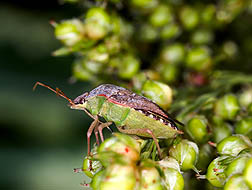This page has been archived and is being provided for reference purposes only. The page is no longer being updated, and therefore, links on the page may be invalid.
Read the magazine story to find out more. |
|
|
Defending Cotton from Stink Bugs
By Sharon DurhamJanuary 16, 2008
Years ago, boll weevils used to bedevil cotton growers—until a successful large-area eradication program eliminated that problem for most U.S. producers. Now, stink bugs have begun to be another problem for cotton growers, costing them about 3 percent of their crop each year. Agricultural Research Service (ARS) scientists in Georgia have been testing the effectiveness of using a combination of trap crops and pheromone traps to alleviate stink bugs’ impact on cotton.
ARS entomologists Glynn Tillman in the Crop Protection and Management Research Laboratory at Tifton, Ga., and Ted Cottrell with the Southeastern Fruit and Nut Research Laboratory in Byron, Ga., are exploring this combination to control two troublesome members of the family Pentatomidae: brown stink bugs (Euschistus servus) and southern green stink bugs (Nezara viridula). Trap crops are small plots of plants specially planted to attract various pests away from cash crops. Pheromones are chemicals produced by an insect or other animal that stimulate a response in others of its kind, often serving as an attractant.
Planting peanut-cotton and corn-cotton farming configurations, or "farmscapes," is common in the Southeast. Stink bugs develop on corn and peanuts, and later they move into adjacent cotton fields when their food supply runs low. However, stink bugs are more attracted to sorghum than to cotton.
So the researchers planted sorghum as a trap crop in a strip along the entire length of the common boundary of a peanut-cotton farmscape and placed pheromone-baited capture traps about 45 to 50 feet apart in the sorghum. The brown stink bug population was significantly lower in cotton fields with the sorghum and pheromone traps than in those without them.
The researchers did the same for a corn-cotton farmscape with southern green stink bugs. Again, the southern green stink bug population was found to be lower in cotton fields with the sorghum trap crop than in cotton fields without it.
ARS is the U.S. Department of Agriculture's chief scientific research agency.
Read more about this research in the January issue of Agricultural Research magazine.

